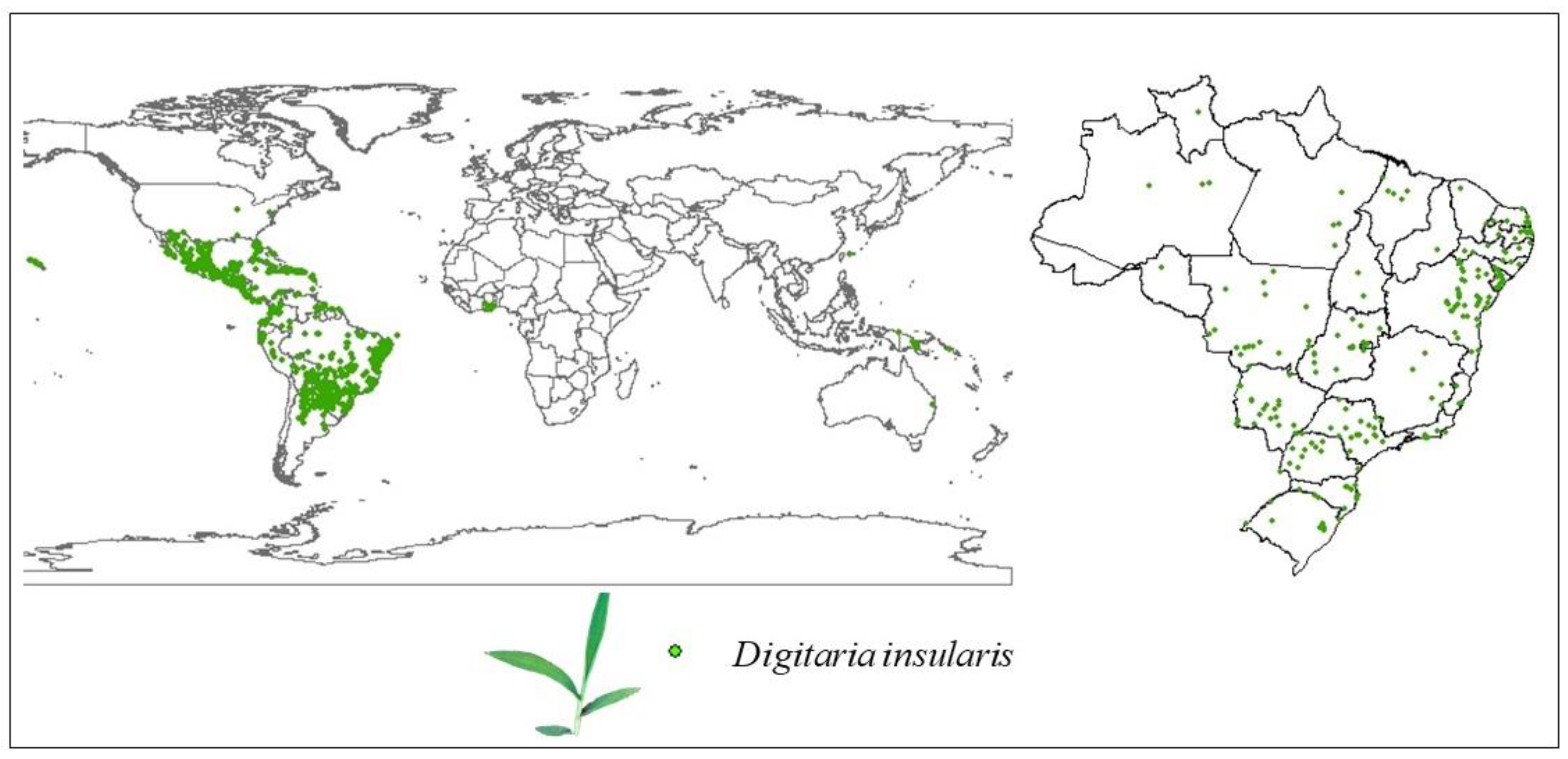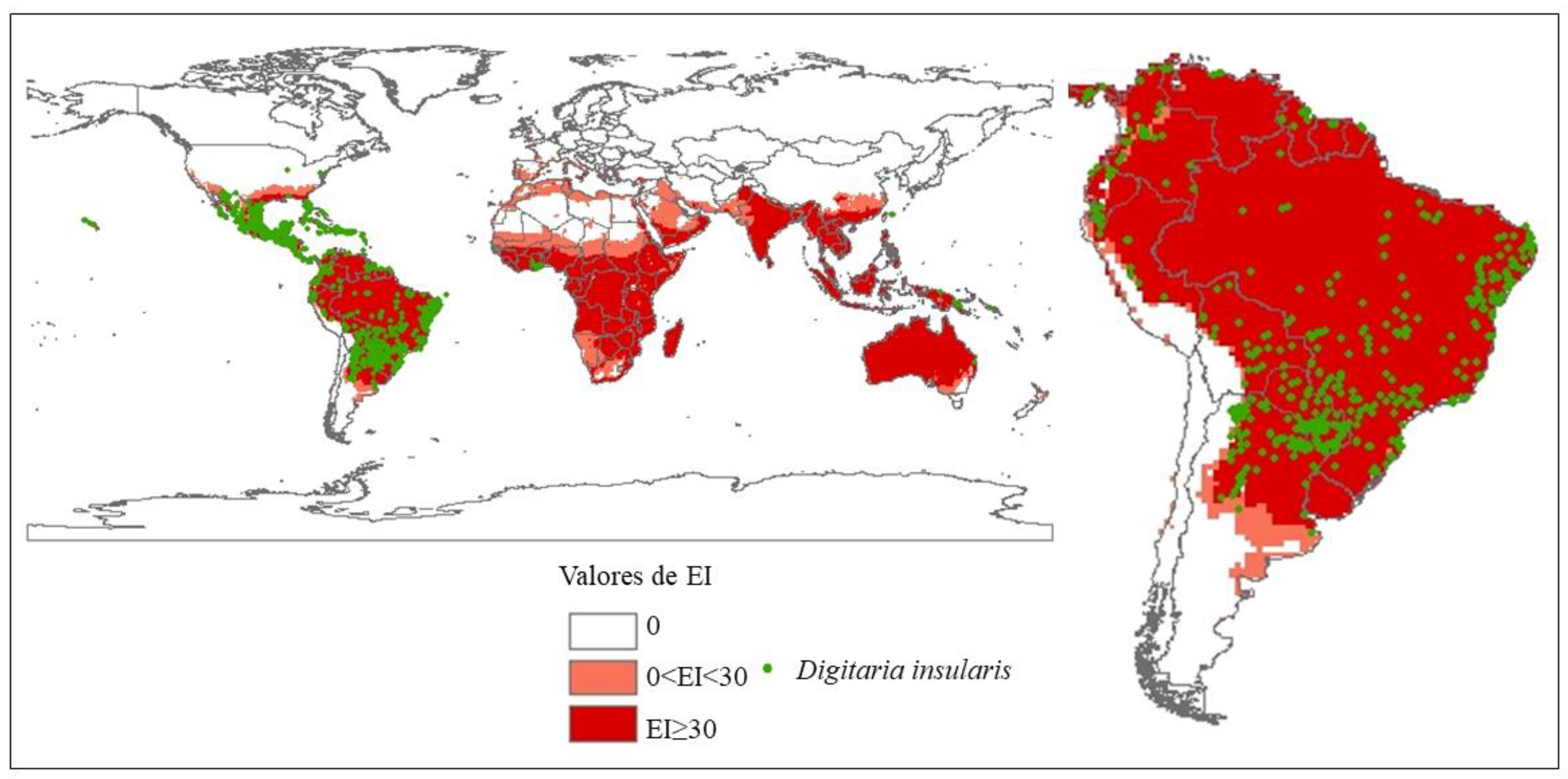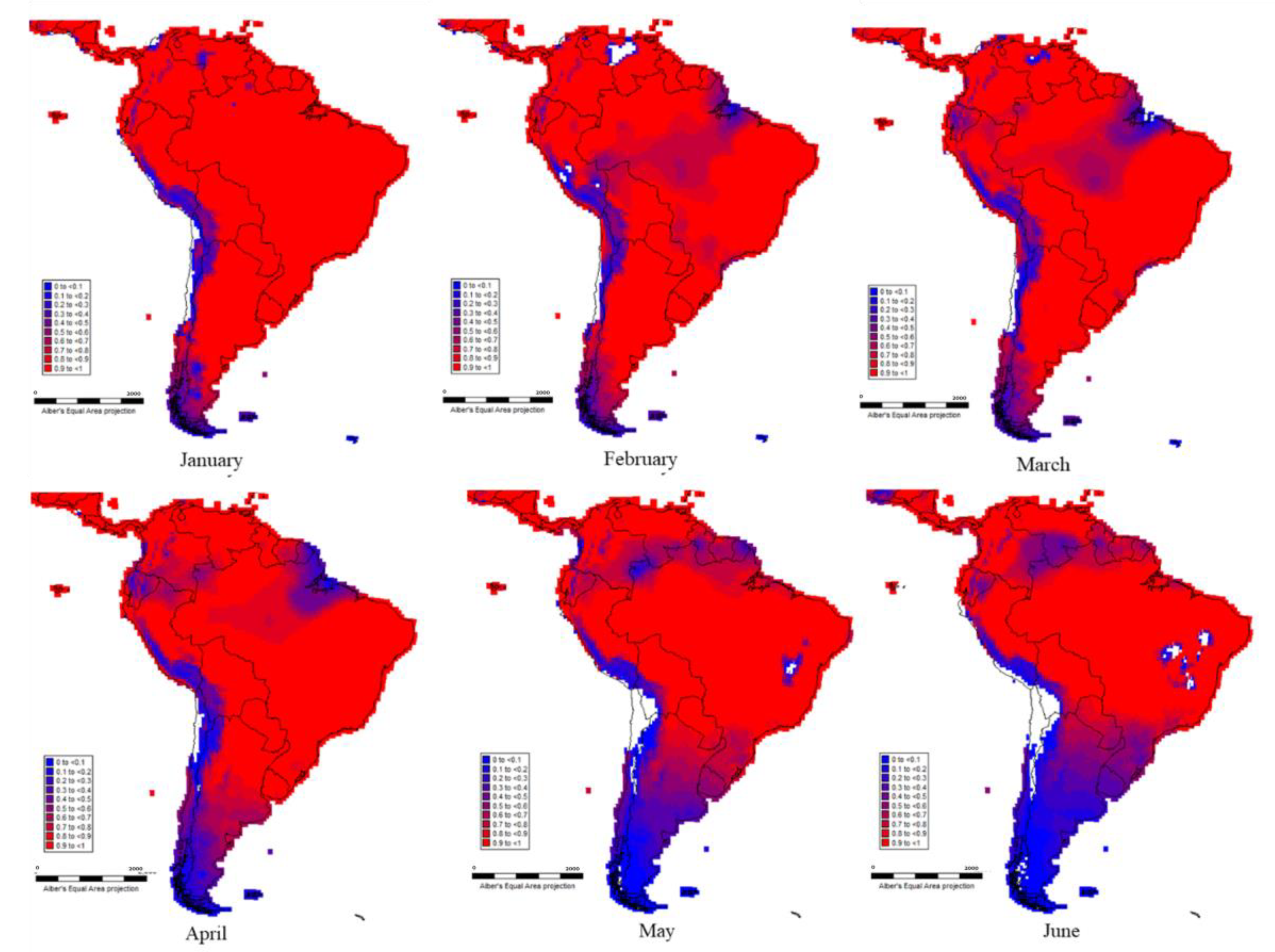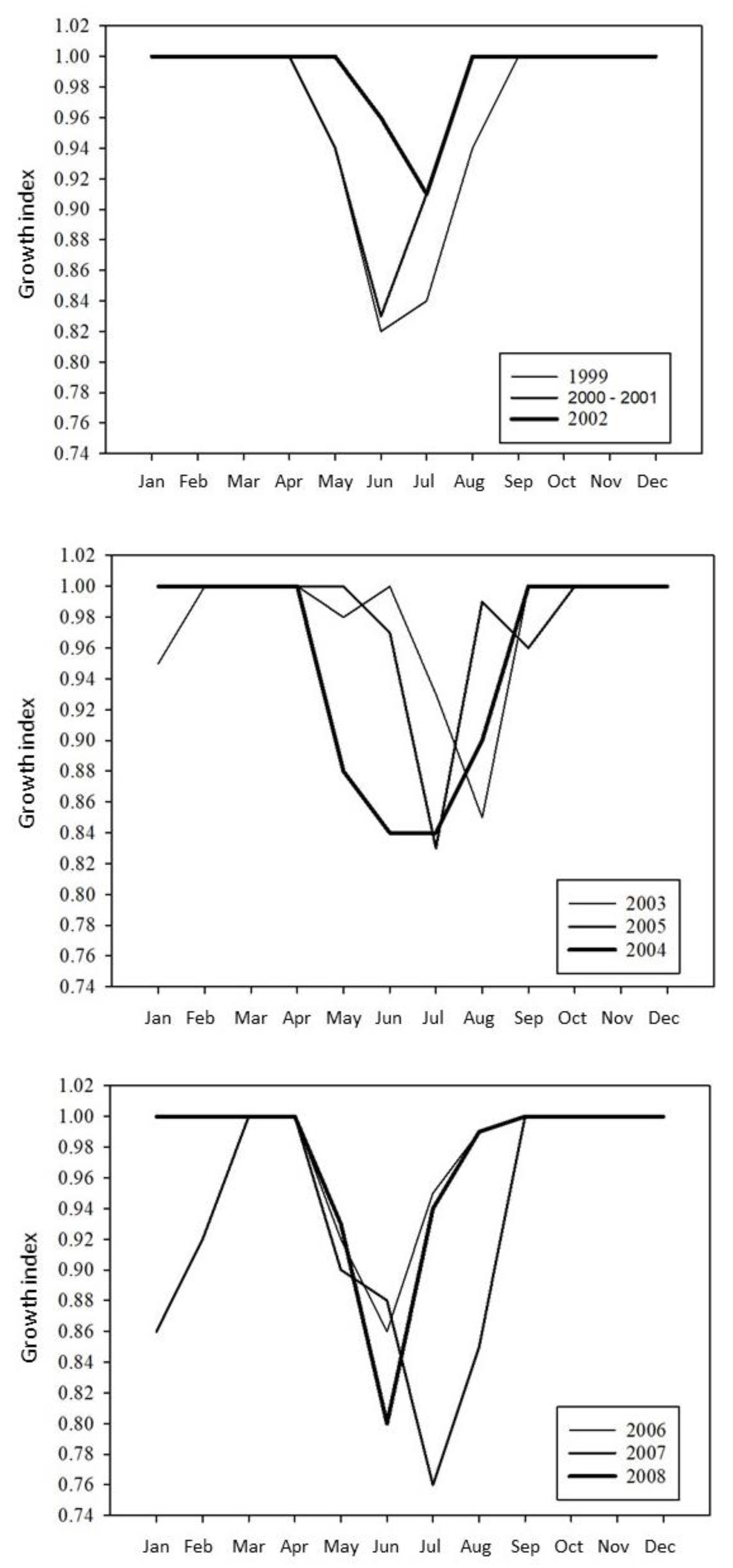Spatio-Temporal Distribution of Digitaria insularis: Risk Analysis of Areas with Potential for Selection of Glyphosate-Resistant Biotypes in Eucalyptus Crops in Brazil
Abstract
:1. Introduction
2. Materials and Methods
2.1. Global Distribution of Digitaria insularis
2.2. Climex
2.3. Parameters Used for Model Creation and Validation
2.3.1. Temperature Index
2.3.2. Moisture Index
2.3.3. Stress Indices
2.3.4. Meteorological Data
2.4. Model Verification and Validation
2.5. Eucalyptus Cultivation Versus Herbicide Consumption
3. Results
4. Discussion
5. Conclusions
Author Contributions
Funding
Institutional Review Board Statement
Informed Consent Statement
Data Availability Statement
Acknowledgments
Conflicts of Interest
References
- IBÁ. Indústria Brasileira de Árvores. Available online: https://iba.org/datafiles/publicacoes/relatorios/relatorioiba2019-final.pdf (accessed on 12 January 2021).
- Wilcken, C.F.; Lima, A.C.V.; Dias, T.K.R.; Masson, M.V.; Ferreira Filho, P.J.; Dal Pogetto, M.H.F.A. Guia Prático de Manejo de Plantações de Eucalipto; FEPAF: Botucatu, Brazil, 2008; p. 19. [Google Scholar]
- Vargas, F.; Rubilar, R.; Gonzalez-Benecke, C.A.; Sanchez-Olate, M.; Aracena, P. Long-term response to area of competition control in Eucalyptus globulus plantations. New For. 2018, 49, 383–398. [Google Scholar] [CrossRef]
- Bacha, A.L.; Pereira, F.C.M.; Pires, R.N.; Nepomuceno, M.P.; Alves, A.L.D.C.A. Interference of seeding and regrowth of sigagrass weed (Urochloa decumbens) during the initial development of Eucalyptus urograndis (E. grandis x E. urophylla). Aust. J. Crop. Sci. 2016, 10, 322. [Google Scholar] [CrossRef]
- Brasil. Normative Instruction No. 112 of October 15, 2018. Official Gazette of the Union: Section 1, p. 4. 15 October 2018. Available online: https://www.jusbrasil.com.br/diarios/212979560/dou-secao-1-15-10-2018-pg-4 (accessed on 24 January 2021).
- Roberts, J.C.; Little, K.M.; Rolando, C. Estimated herbicide use in the commercial forest sector in South Africa. Aust. For. 2021, 1, 1–14. [Google Scholar] [CrossRef]
- Boutin, C.; Strandberg, B.; Carpenter, D.; Mathiassen, S.K.; Thomas, P.J. Herbicide impact on non-target plant reproduction: What are the toxicological and ecological implications? Environ. Pollut. 2014, 185, 295–306. [Google Scholar] [CrossRef] [PubMed] [Green Version]
- Santos, E.A.; Correia, N.M.; Silva, J.R.M.; Velini, E.D.; Durigan, J.C.; Passos, A.B.R.J.; Teixeira, M.F.F. Occurrence of waste herbicides in surface water from North of São Paulo (Brazil). J. Exp. Agric. Int. 2017, 17, 1–9. [Google Scholar] [CrossRef]
- Borges, M.P.S.B.; Silva, D.V.; Freitas Souza, M.; Silva, T.S.; Teófilo, T.M.S.; da Silva, C.C.; Pavão, Q.S.; Jesus Passos, A.B.R.; dos Santos, J.B. Glyphosate effects on tree species natives from Cerrado and Caatinga Brazilian biome: Assessing sensitivity to two ways of contamination. Sci. Total. Environ. 2021, 769, 144113. [Google Scholar] [CrossRef]
- Gaines, T.A.; Duke, S.O.; Morran, S.; Rigon, C.A.; Tranel, P.J.; Küpper, A.; Dayan, F.E. Mechanisms of evolved herbicide resistance. J. Biol. Chem. 2020, 295, 10307–10330. [Google Scholar] [CrossRef]
- Ovejero, R.F.L.; Takano, H.K.; Nicolai, M.; Ferreira, A.; Melo, M.S.; Cavenaghi, A.L.; Oliveira, R.S. Frequency and dispersal of glyphosate-resistant sourgrass (Digitaria insularis) populations across Brazilian agricultural production areas. Weed Sci. 2017, 65, 285–294. [Google Scholar] [CrossRef]
- MAPA—Ministério da Agricultura, Pecuária e Abastecimneto. Available online: http://extranet.agricultura.gov.br/agrofit_cons/principal_agrofit_cons (accessed on 11 February 2021).
- Guisan, A.; Thuiller, W. Predicting species distribution: Offering more than simple habitat models. Ecol. Lett. 2005, 8, 993–1009. [Google Scholar] [CrossRef]
- Elith, J. Predicting distributions of invasive species. Invasive Species Risk Assess. Manag. 2017, 10, 9781139019606.006. [Google Scholar]
- da Silva, R.S.; Kumar, L.; Shabani, F.; Picanço, M.C. An analysis of sensitivity of CLIMEX parameters in mapping species potential distribution and the broad-scale changes observed with minor variations in parameters values: An investigation using open-field Solanum lycopersicum and Neoleucinodes elegantalis as an example. Theor. Appl. Climatol. 2018, 132, 135–144. [Google Scholar]
- dos Santos, E.A.; da Cunha, D.A.; dos Santos, J.B.; Zanúncio, J.C. Agricultural vulnerability to climate change in the Rio das Contas Basin, Brazil. Int. J. Environ. Sci. Technol. 2021, 1, 1–12. [Google Scholar]
- Chaves, M.E.; Alves, M.D.C.; Sáfadi, T.; de Oliveira, M.S.; Picoli, M.C.; Simoes, R.E.; Mataveli, G.A. Time-weighted dynamic time warping analysis for mapping interannual cropping practices changes in large-scale agro-industrial farms in Brazilian Cerrado. Sci. Remote Sens. 2021, 3, 100021. [Google Scholar] [CrossRef]
- Wilson, O.J.; Mayle, F.E.; Walters, R.J.; Lingner, D.V.; Vibrans, A.C. Floristic change in Brazil’s Southern Atlantic Forest biodiversity hotspot: From the last glacial maximum to the late 21st century. Quat. Sci. Rev. 2021, 264, 107005. [Google Scholar] [CrossRef]
- Shabani, F.; Kumar, L. Sensitivity analysis of CLIMEX parameters in modeling potential distribution of Phoenix dactylifera L. PLoS ONE 2014, 9, e94867. [Google Scholar] [CrossRef] [Green Version]
- Shabani, F.; Kotey, B. Future distribution of cotton and wheat in Australia under potential climate change. J. Agric. Sci. 2016, 154, 175–185. [Google Scholar] [CrossRef]
- Silva, R.S.; Kumar, L.; Shabani, F.; Picanço, M.C. Potential risk levels of invasive Neoleucinodes elegantalis (small tomato borer) in areas optimal for open-field Solanum lycopersicum (tomato) cultivation in the present and under predicted climate change. Pest Manag. Sci. 2017, 73, 616–627. [Google Scholar] [CrossRef] [PubMed] [Green Version]
- Kriticos, D.J.; Maywald, G.F.; Yonow, T.; Zurcher, E.J.; Herrmann, N.I.; Sutherst, R. Exploring the Effects of Climate on Plants, Animals and Diseases, CLIMEX Version 4; CSIRO: Canberra, Australia, 2015; p. 184.
- GBIF—Global Biodiversity Information Facility. Available online: https://www.gbif.org/species/5289938 (accessed on 24 January 2021).
- EPPO—European and Mediterranean Plant Protection Organization. Available online: https://www.eppo.int/ (accessed on 24 January 2021).
- USDA—United States Department of Agriculture. Available online: https://www.usda.gov/ (accessed on 24 January 2021).
- Martins, J.F.; Barroso, A.A.M.; Alves, P.L.C.A. Effects of environmental factors on seed germination and emergence of glyphosate resistant and susceptible sourgrass. Planta Daninha 2017, 35, e017164499. [Google Scholar] [CrossRef] [Green Version]
- Marques, B.S.; Silva, A.P.P.; Lima, R.S.O.; Machado, E.C.R.; Gonçalves, M.F.; Carvalho, S.J.P. Growth and development of sourgrass based on days or thermal units. Planta Daninha 2014, 32, 483–490. [Google Scholar] [CrossRef] [Green Version]
- HEAP—The International Survey of Herbicide Resistance. Available online: www.weedscience.org/Pages/Species.aspx (accessed on 31 August 2021).
- IBAMA—Instituto Brasileiro do Meio Ambiente e dos Recursos Naturais Renováveis. Available online: https://www.ibama.gov.br/agrotoxicos/relatorios-de-comercializacao-de-agrotoxicos#sobreosrelatorios (accessed on 12 January 2021).
- Hager, H.A.; Sinasac, S.E.; Gedalof, Z.E.; Newman, J.A. Predicting potential global distributions of two Miscanthus grasses: Implications for horticulture, biofuel production, and biological invasions. PLoS ONE 2014, 9, e100032. [Google Scholar] [CrossRef] [Green Version]
- Chejara, V.K.; Kriticos, D.J.; Kristiansen, P.; Sindel, B.M.; Whalley, R.D.B.; Nadolny, C. The current and future potential geographical distribution of Hyparrhenia hirta. Weed Res. 2010, 50, 174–184. [Google Scholar] [CrossRef]
- Takano, H.K.; de Oliveira, J.R.S.; Constantin, J.; Mangolim, C.A.; Machado, M.D.F.; Bevilaqua, M.R. Spread of glyphosate-resistant sourgrass (Digitaria insularis): Independent selections or merely propagule dissemination? Weed Biol. Manag. 2018, 18, 50–59. [Google Scholar] [CrossRef]
- Lacerda, A.L.D.S. Fluxos de Emergência e Banco de Sementes de Plantas Daninhas em Sistemas de Semeadura Direta e Convencional e Curvas Dose-Resposta ao Glyphosate. Ph.D. Thesis, ESALQ/USP, Piracicaba, Brazil, 2003. [Google Scholar]
- Mendonça, G.S.D.; Martins, C.C.; Martins, D.; Costa, N.V.D. Ecophysiology of seed germination in Digitaria insularis ((L.) Fedde). Revista Ciência Agronômica 2014, 45, 823–832. [Google Scholar] [CrossRef]
- Jung, J.M.; Jung, S.; Byeon, D.H.; Lee, W.H. Model-based prediction of potential distribution of the invasive insect pest, spotted lanternfly Lycorma delicatula (Hemiptera: Fulgoridae), by using CLIMEX. J. Asia-Pac. Biodivers. 2017, 10, 532–538. [Google Scholar] [CrossRef]
- Ramirez-Cabral, N.Y.; Kumar, L.; Shabani, F. Global alterations in areas of suitability for maize production from climate change and using a mechanistic species distribution model (CLIMEX). Sci. Rep. 2017, 7, 1–13. [Google Scholar] [CrossRef]
- Magarey, R.; Newton, L.; Hong, S.C.; Takeuchi, Y.; Christie, D.; Jarnevich, C.S.; Koop, A.L. Comparison of four modeling tools for the prediction of potential distribution for non-indigenous weeds in the United States. Biol. Invasions 2018, 20, 679–694. [Google Scholar] [CrossRef]
- Farooq, S.; Maqbool, M.M.; Bashir, M.A.; Ullah, M.I.; Shah, R.U.; Ali, H.M.; Wang, Y.F. Production suitability of date palm under changing climate in a semi-arid region predicted by CLIMEX model. J. King Saud Univ.-Sci. 2021, 33, 101394. [Google Scholar] [CrossRef]
- Soares, J.R.S.; da Silva, R.S.; Ramos, R.S.; Picanço, M.C. Distribution and invasion risk assessments of Chrysodeixis includens (Walker, [1858]) (Lepidoptera: Noctuidae) using CLIMEX. Int. J. Biometeorol. 2021, 65, 1137–1149. [Google Scholar] [CrossRef] [PubMed]






| States | Records of D. insularis | States | Records of D. insularis |
|---|---|---|---|
| Acre | 0 | Paraíba | 10 |
| Alagoas | 3 | Paraná | 17 |
| Amapá | 0 | Pernambuco | 14 |
| Amazonas | 8 | Piauí | 3 |
| Bahia | 54 | Rio de Janeiro | 7 |
| Ceará | 1 | Rio Grande do Norte | 9 |
| Espírito Santo | 3 | Rio Grande Sul | 13 |
| Goiás | 25 | Rondônia | 1 |
| Maranhão | 11 | Roraima | 1 |
| Mato Grosso | 18 | Santa Catarina | 15 |
| Mato Grosso Sul | 23 | São Paulo | 21 |
| Minas Gerais | 10 | Sergipe | 13 |
| Pará | 7 | Tocantins | 2 |
Publisher’s Note: MDPI stays neutral with regard to jurisdictional claims in published maps and institutional affiliations. |
© 2021 by the authors. Licensee MDPI, Basel, Switzerland. This article is an open access article distributed under the terms and conditions of the Creative Commons Attribution (CC BY) license (https://creativecommons.org/licenses/by/4.0/).
Share and Cite
Barroso, G.M.; da Silva, R.S.; Mucida, D.P.; Borges, C.E.; Ferreira, S.R.; dos Santos, J.C.B.; Lins, H.A.; Mendonça, V.; Silva, D.V.; dos Santos, J.B. Spatio-Temporal Distribution of Digitaria insularis: Risk Analysis of Areas with Potential for Selection of Glyphosate-Resistant Biotypes in Eucalyptus Crops in Brazil. Sustainability 2021, 13, 10405. https://doi.org/10.3390/su131810405
Barroso GM, da Silva RS, Mucida DP, Borges CE, Ferreira SR, dos Santos JCB, Lins HA, Mendonça V, Silva DV, dos Santos JB. Spatio-Temporal Distribution of Digitaria insularis: Risk Analysis of Areas with Potential for Selection of Glyphosate-Resistant Biotypes in Eucalyptus Crops in Brazil. Sustainability. 2021; 13(18):10405. https://doi.org/10.3390/su131810405
Chicago/Turabian StyleBarroso, Gabriela Madureira, Ricardo Siqueira da Silva, Danielle Piuzana Mucida, Cláudia Eduarda Borges, Sabrina Rodrigues Ferreira, José Carlos Barbosa dos Santos, Hamurábi Anizio Lins, Vander Mendonça, Daniel Valadão Silva, and José Barbosa dos Santos. 2021. "Spatio-Temporal Distribution of Digitaria insularis: Risk Analysis of Areas with Potential for Selection of Glyphosate-Resistant Biotypes in Eucalyptus Crops in Brazil" Sustainability 13, no. 18: 10405. https://doi.org/10.3390/su131810405






